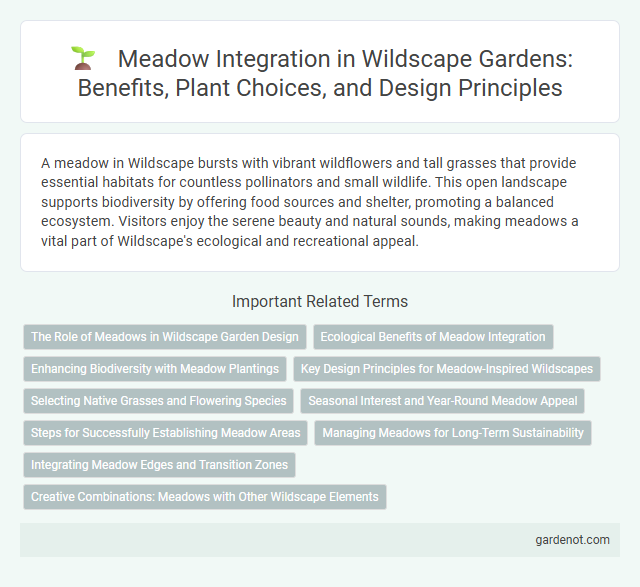A meadow in Wildscape bursts with vibrant wildflowers and tall grasses that provide essential habitats for countless pollinators and small wildlife. This open landscape supports biodiversity by offering food sources and shelter, promoting a balanced ecosystem. Visitors enjoy the serene beauty and natural sounds, making meadows a vital part of Wildscape's ecological and recreational appeal.
The Role of Meadows in Wildscape Garden Design
Meadows play a crucial role in Wildscape garden design by enhancing biodiversity and providing habitat for pollinators such as bees, butterflies, and native birds. These plant-rich areas support soil health and natural pest control through diverse wildflowers and grasses that thrive without intensive maintenance. Incorporating meadows into Wildscape designs promotes ecological balance while creating visually dynamic and sustainable landscapes.
Ecological Benefits of Meadow Integration
Meadow integration enhances biodiversity by providing habitats for pollinators, birds, and small mammals, supporting ecosystem resilience and stability. Native grasses and wildflowers in meadows improve soil health through natural nitrogen fixation and erosion control, promoting sustainable land management. Meadows also contribute to carbon sequestration, reducing greenhouse gases and mitigating climate change impacts in urban and rural landscapes.
Enhancing Biodiversity with Meadow Plantings
Meadow plantings significantly enhance biodiversity by providing native habitats that support a wide variety of pollinators, birds, and small mammals. Incorporating diverse wildflower species tailored to local soil and climate conditions promotes ecological balance and resilience. These meadows also improve soil health and water retention, contributing to sustainable landscape management.
Key Design Principles for Meadow-Inspired Wildscapes
Meadow-inspired wildscapes prioritize native plant diversity, seasonal bloom cycles, and habitat connectivity to support pollinators and wildlife. Designing with layered vegetation structure enhances soil health and natural water retention, promoting ecosystem resilience. Integrating sustainable maintenance practices like minimal mowing and organic soil amendments sustains meadow vitality and biodiversity over time.
Selecting Native Grasses and Flowering Species
Selecting native grasses such as Little Bluestem and Switchgrass enhances Meadow ecosystems by providing essential habitat and supporting local wildlife. Incorporating flowering species like Black-eyed Susan and Purple Coneflower ensures seasonal pollinator attraction and promotes biodiversity. Native plants' adaptation to local soil and climate conditions improves resilience and reduces maintenance requirements in Meadow restoration projects.
Seasonal Interest and Year-Round Meadow Appeal
Meadows offer vibrant seasonal interest with blooming wildflowers in spring and summer, transitioning to golden grasses and seed heads in autumn. These dynamic landscapes support diverse pollinators and wildlife throughout the year, enhancing ecological balance. Their year-round appeal provides continuous visual texture and habitat value, making them essential components of wildscape design.
Steps for Successfully Establishing Meadow Areas
Preparing soil by removing debris and ensuring proper drainage establishes a strong foundation for meadow growth. Selecting native wildflowers and grasses adapted to local climate promotes biodiversity and ecological balance. Regular monitoring and minimal mowing during late seasons encourage healthy plant development and sustainable habitat creation.
Managing Meadows for Long-Term Sustainability
Managing meadows for long-term sustainability involves implementing rotational grazing and periodic mowing to maintain plant biodiversity and prevent shrub encroachment. Incorporating native wildflowers enhances pollinator habitats, supporting ecosystem resilience. Soil health is preserved through minimal chemical use and maintaining proper drainage to sustain meadow productivity over time.
Integrating Meadow Edges and Transition Zones
Integrating meadow edges and transition zones enhances biodiversity by providing habitat gradients that support diverse plant and wildlife species. Native grasses and wildflowers planted along meadow perimeters create natural buffers that improve soil health and pollinator activity. These ecotones also help manage water runoff and reduce erosion, promoting ecological resilience in Wildscape designs.
Creative Combinations: Meadows with Other Wildscape Elements
Meadows in wildscape design create vibrant habitats by combining native wildflowers, grasses, and pollinator-friendly plants that attract bees, butterflies, and birds. Integrating features like water bodies, rocky outcrops, or native shrubs enhances biodiversity and supports diverse wildlife throughout the seasons. Strategic layering of these elements mimics natural ecosystems, promoting ecological balance and sustainable habitat restoration.
Meadow Infographic

 gardenot.com
gardenot.com